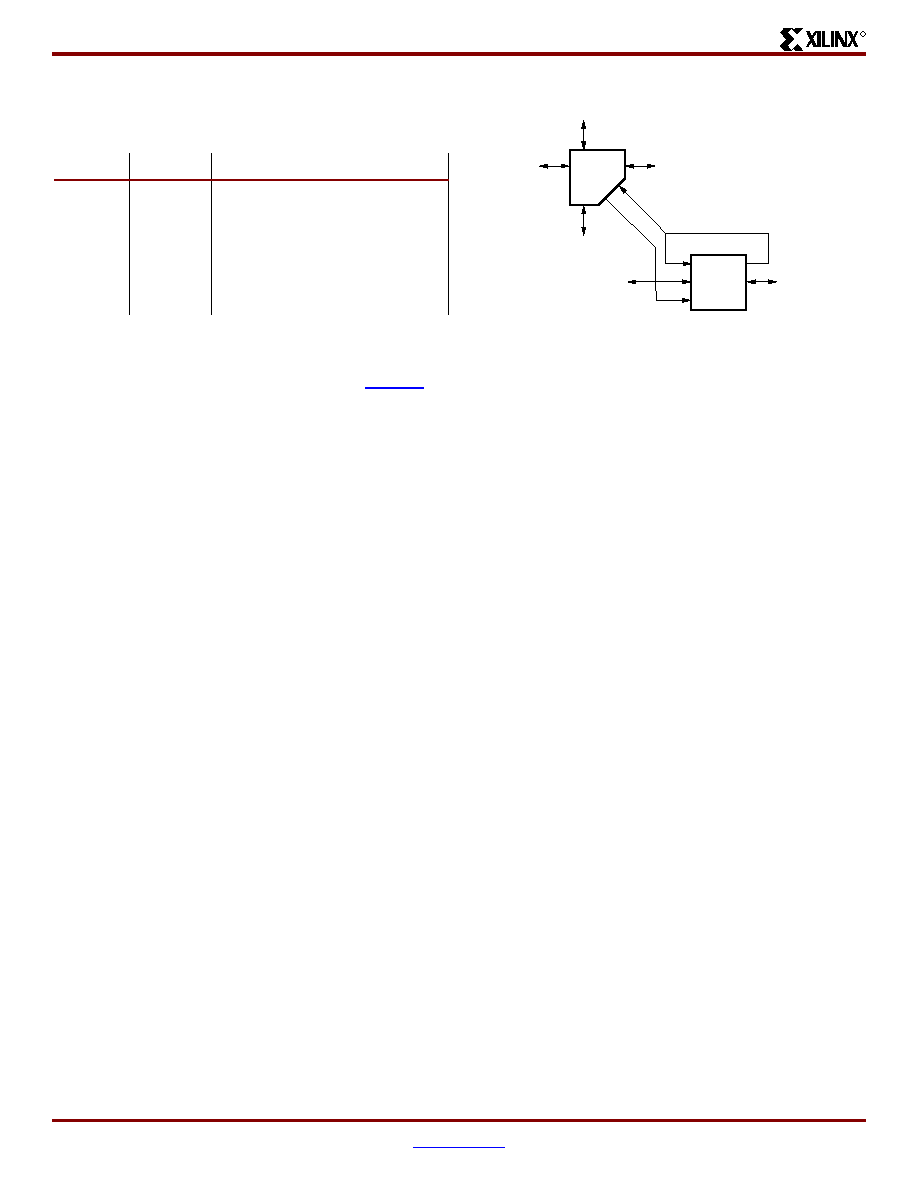- 您現(xiàn)在的位置:買(mǎi)賣(mài)IC網(wǎng) > PDF目錄4280 > XC2S200E-6PQ208I (Xilinx Inc)IC FPGA 1.8V 1176 CLB'S 208-PQFP PDF資料下載
參數(shù)資料
| 型號(hào): | XC2S200E-6PQ208I |
| 廠商: | Xilinx Inc |
| 文件頁(yè)數(shù): | 17/108頁(yè) |
| 文件大?。?/td> | 0K |
| 描述: | IC FPGA 1.8V 1176 CLB'S 208-PQFP |
| 標(biāo)準(zhǔn)包裝: | 24 |
| 系列: | Spartan®-IIE |
| LAB/CLB數(shù): | 1176 |
| 邏輯元件/單元數(shù): | 5292 |
| RAM 位總計(jì): | 57344 |
| 輸入/輸出數(shù): | 146 |
| 門(mén)數(shù): | 200000 |
| 電源電壓: | 1.71 V ~ 1.89 V |
| 安裝類(lèi)型: | 表面貼裝 |
| 工作溫度: | -40°C ~ 100°C |
| 封裝/外殼: | 208-BFQFP |
| 供應(yīng)商設(shè)備封裝: | 208-PQFP(28x28) |
| 其它名稱(chēng): | Q5479689 |
第1頁(yè)第2頁(yè)第3頁(yè)第4頁(yè)第5頁(yè)第6頁(yè)第7頁(yè)第8頁(yè)第9頁(yè)第10頁(yè)第11頁(yè)第12頁(yè)第13頁(yè)第14頁(yè)第15頁(yè)第16頁(yè)當(dāng)前第17頁(yè)第18頁(yè)第19頁(yè)第20頁(yè)第21頁(yè)第22頁(yè)第23頁(yè)第24頁(yè)第25頁(yè)第26頁(yè)第27頁(yè)第28頁(yè)第29頁(yè)第30頁(yè)第31頁(yè)第32頁(yè)第33頁(yè)第34頁(yè)第35頁(yè)第36頁(yè)第37頁(yè)第38頁(yè)第39頁(yè)第40頁(yè)第41頁(yè)第42頁(yè)第43頁(yè)第44頁(yè)第45頁(yè)第46頁(yè)第47頁(yè)第48頁(yè)第49頁(yè)第50頁(yè)第51頁(yè)第52頁(yè)第53頁(yè)第54頁(yè)第55頁(yè)第56頁(yè)第57頁(yè)第58頁(yè)第59頁(yè)第60頁(yè)第61頁(yè)第62頁(yè)第63頁(yè)第64頁(yè)第65頁(yè)第66頁(yè)第67頁(yè)第68頁(yè)第69頁(yè)第70頁(yè)第71頁(yè)第72頁(yè)第73頁(yè)第74頁(yè)第75頁(yè)第76頁(yè)第77頁(yè)第78頁(yè)第79頁(yè)第80頁(yè)第81頁(yè)第82頁(yè)第83頁(yè)第84頁(yè)第85頁(yè)第86頁(yè)第87頁(yè)第88頁(yè)第89頁(yè)第90頁(yè)第91頁(yè)第92頁(yè)第93頁(yè)第94頁(yè)第95頁(yè)第96頁(yè)第97頁(yè)第98頁(yè)第99頁(yè)第100頁(yè)第101頁(yè)第102頁(yè)第103頁(yè)第104頁(yè)第105頁(yè)第106頁(yè)第107頁(yè)第108頁(yè)

16
DS077-2 (v3.0) August 9, 2013
Product Specification
Spartan-IIE FPGA Family: Functional Description
R
— OBSOLETE — OBSOLETE — OBSOLETE — OBSOLETE —
Table 7 shows the depth and width aspect ratios for the
block RAM.
The Spartan-IIE FPGA block RAM also includes dedicated
routing to provide an efficient interface with both CLBs and
other block RAMs. See Xilinx Application Note XAPP173 for
more information on block RAM.
Programmable Routing
It is the longest delay path that limits the speed of any
design. Consequently, the Spartan-IIE FPGA routing archi-
tecture and its place-and-route software were defined jointly
to minimize long-path delays and yield the best system per-
formance.
The joint optimization also reduces design compilation
times because the architecture is software-friendly. Design
cycles are correspondingly reduced due to shorter design
iteration times.
The software automatically uses the best available routing
based on user timing requirements. The details are pro-
vided here for reference.
Local Routing
The local routing resources, as shown in Figure 9, provide
the following three types of connections:
Interconnections among the LUTs, flip-flops, and
General Routing Matrix (GRM), described below.
Internal CLB feedback paths that provide high-speed
connections to LUTs within the same CLB, chaining
them together with minimal routing delay
Direct paths that provide high-speed connections
between horizontally adjacent CLBs, eliminating the
delay of the GRM
General Purpose Routing
Most Spartan-IIE FPGA signals are routed on the general
purpose routing, and consequently, the majority of intercon-
nect resources are associated with this level of the routing
hierarchy. The general routing resources are located in hor-
izontal and vertical routing channels associated with the
rows and columns of CLBs. The general-purpose routing
resources are listed below.
Adjacent to each CLB is a General Routing Matrix
(GRM). The GRM is the switch matrix through which
horizontal and vertical routing resources connect, and
is also the means by which the CLB gains access to
the general purpose routing.
24 single-length lines route GRM signals to adjacent
GRMs in each of the four directions.
96 buffered Hex lines route GRM signals to other
GRMs six blocks away in each one of the four
directions. Organized in a staggered pattern, Hex lines
may be driven only at their endpoints. Hex-line signals
can be accessed either at the endpoints or at the
midpoint (three blocks from the source). One third of
the Hex lines are bidirectional, while the remaining
ones are unidirectional.
12 Longlines are buffered, bidirectional wires that
distribute signals across the device quickly and
efficiently. Vertical Longlines span the full height of the
device, and horizontal ones span the full width of the
device.
I/O Routing
Spartan-IIE devices have additional routing resources
around their periphery that form an interface between the
CLB array and the IOBs. This additional routing, called the
VersaRing routing, facilitates pin-swapping and pin-lock-
ing, such that logic redesigns can adapt to existing PCB lay-
outs. Time-to-market is reduced, since PCBs and other
system components can be manufactured while the logic
design is still in progress.
Table 7: Block RAM Port Aspect Ratios
Width
Depth
ADDR Bus
Data Bus
1
4096
ADDR<11:0>
DATA<0>
2
2048
ADDR<10:0>
DATA<1:0>
4
1024
ADDR<9:0>
DATA<3:0>
8
512
ADDR<8:0>
DATA<7:0>
16
256
ADDR<7:0>
DATA<15:0>
Figure 9: Spartan-IIE Local Routing
DS001_06_032300
CLB
GRM
To
Adjacent
GRM
To Adjacent
GRM
Direct
Connection
To Adjacent
CLB
To Adjacent
GRM
To Adjacent
GRM
Direct Connection
To Adjacent
CLB
相關(guān)PDF資料 |
PDF描述 |
|---|---|
| 5205817-1 | CONN SCREWLOCK FEMALE 2 SETS/BAG |
| XC6SLX25-N3FTG256C | IC FPGA SPARTAN-6 256FBGA |
| XC2V40-5CSG144C | IC FPGA VIRTEX-II 40K 144-CSBGA |
| 5745563-1 | CONN D-SUB FEMALE SCREW LOCK |
| XC2V40-4CSG144I | IC FPGA VIRTEX-II 40K 144-CSBGA |
相關(guān)代理商/技術(shù)參數(shù) |
參數(shù)描述 |
|---|---|
| XC2S200E-6PQG208C | 功能描述:IC SPARTAN-IIE FPGA 200K 208PQFP RoHS:是 類(lèi)別:集成電路 (IC) >> 嵌入式 - FPGA(現(xiàn)場(chǎng)可編程門(mén)陣列) 系列:Spartan®-IIE 標(biāo)準(zhǔn)包裝:40 系列:Spartan® 6 LX LAB/CLB數(shù):3411 邏輯元件/單元數(shù):43661 RAM 位總計(jì):2138112 輸入/輸出數(shù):358 門(mén)數(shù):- 電源電壓:1.14 V ~ 1.26 V 安裝類(lèi)型:表面貼裝 工作溫度:-40°C ~ 100°C 封裝/外殼:676-BGA 供應(yīng)商設(shè)備封裝:676-FBGA(27x27) |
| XC2S200E-6PQG208I | 制造商:XILINX 制造商全稱(chēng):XILINX 功能描述:Spartan-IIE FPGA |
| XC2S200E-6TQ144C | 制造商:XILINX 制造商全稱(chēng):XILINX 功能描述:Spartan-IIE 1.8V FPGA Family |
| XC2S200E-6TQ144I | 制造商:XILINX 制造商全稱(chēng):XILINX 功能描述:Spartan-IIE 1.8V FPGA Family |
| XC2S200E-6TQG144C | 制造商:XILINX 制造商全稱(chēng):XILINX 功能描述:Spartan-IIE FPGA |
發(fā)布緊急采購(gòu),3分鐘左右您將得到回復(fù)。